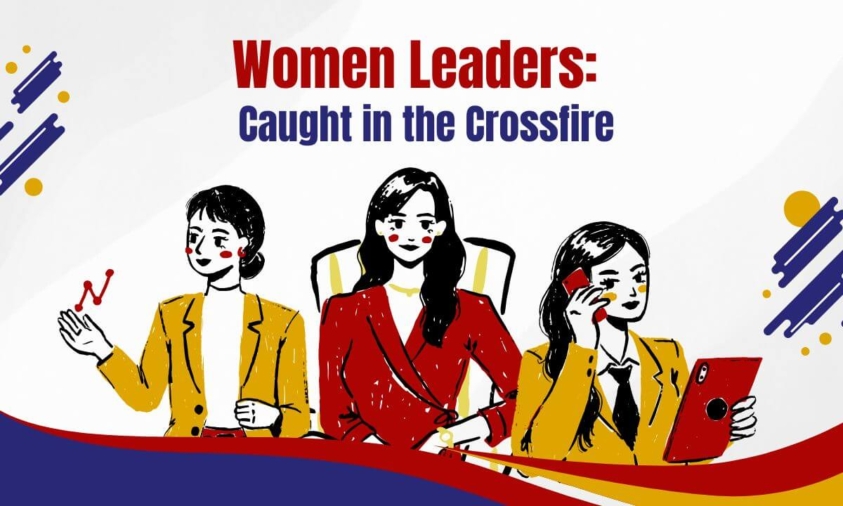Society typically associates leadership with traits of assertiveness, confidence, and decisiveness that are often categorized as “masculine.” But when women exhibit these traits, they are frequently judged harshly, called “too aggressive” or “unlikable.”
On the other side, they run the risk of being written off as “too soft” or “not strong enough” to lead if they exhibit warmth, empathy, or kindness qualities that are typically associated with women.
Despite women’s tremendous accomplishments in education and the workplace over the last few decades, men still outnumber women in leadership roles, particularly at the top.
This puts women in leadership roles in a difficult position. They often feel they have to walk a fine line between being strong and being liked.
These stereotypes can lead to feelings of self-doubt, frustration, and isolation, as women may struggle to prove their worth in environments that don’t always recognize their talents.
These gender disparities persist despite evidence that women’s equal participation in leadership and decision-making is essential for promoting other aspects of gender equality,
To identify the factors causing women to be underrepresented in leadership positions in the financial and economic sectors, ID insight carried out formative research in Ethiopia, India, Kenya, and Nigeria in 2022.
According to insights from 21% of women, 25% of whom work in finance, and 18% in economics indicates that gender prejudice and stereotypes are among the biggest obstacles to women’s advancement into leadership roles.
Cultural stereotypes also contribute to the low number of women who receive promotions. There is sort of a stereotype that men do better than women in this kind of profession. The percentage of women found in leadership roles is not as much as the ones found in men.
Leaders are primarily perceived as possessing masculine traits and attributes that are more akin to those of men than women.
Stereotypically, men are described as aggressive, ambitious, assertive, independent, self-sufficient, self-assured, and likely to take on leadership roles.
While women are based on societal traits that depict them as kind, helpful, compassionate, empathetic, sensitive to others, nurturing, and gentle.
Accordingly, men are assumed to be more eligible than women for leadership positions.
Moreover, these biases can limit opportunities for women, making it harder for them to advance in their careers. The emotional toll of constantly battling these stereotypes can be overwhelming, affecting their confidence and overall well-being.
Understanding how these stereotypes affect women leaders is crucial in creating a more supportive and inclusive environment where all leaders can thrive.
The pressing question is how do we break this cycle?
Research indicates that exposure to female colleagues and leaders can help alter biases and adopt more egalitarian attitudes.
Hiring women into senior leadership positions can help shift organizational language and perceptions toward more agentic descriptions of women leaders, reducing stereotype-driven barriers.
Organization-level initiatives can foster workplace cultures that recognize and address discriminatory selection and promotion procedures.
Providing Equal Resources and Opportunities
- Ensuring equal access to resources like mentorship programs, professional development opportunities, and support systems for all employees.
Creating Inclusive Work Environments
- By promoting open discussions on gender bias and implementing policies like blind resume reviews to eliminate unconscious bias.
Promoting Flexible Work Arrangements
- Inclusive workplaces offering flexible work policies, such as remote work, job-sharing, and enhanced parental leave for all genders. This challenges traditional assumptions that caregiving is solely a woman’s responsibility and normalizes work-life balance for everyone.
- By enabling men to take on caregiving roles, workplaces break down rigid gender roles and encourage shared responsibilities.
Encouraging Diverse Leadership
- Actively hiring and promoting women and individuals of diverse gender identities into leadership positions challenges the stereotype that leadership is inherently masculine.
- Women in decision-making jobs are normalized by this visibility, which also expands ideas about their capacity for leadership.
Creating Supportive Policies
- Policies such as anti-discrimination measures, transparent hiring practices, and gender-neutral facilities ensure that all employees feel valued and respected regardless of their gender identity or expression.
- This helps eliminate stereotypes tied to traditional gender roles.
Women leaders face a great deal of difficulty navigating the double bind of gender stereotypes, which can leave them “damned if they do, doomed if they don’t.” These extreme perceptions can lead to burnout and hinder their career progression
Overcoming gender stereotypes in leadership is a multifaceted challenge that requires both individual resilience and systemic transformation. By combining self-confidence, assertiveness, mentorship, inclusive policies, and societal awareness, we can create a more equitable environment where women leaders thrive.
We need to foster environments where women are celebrated for their unique qualities and contributions, rather than constrained by limiting stereotypes.
By supporting one another and advocating for equity, we can create a world where all leaders regardless of gender are empowered to shine brightly.
Get in touch with us at +919004521614 or [email protected] to discover how your organization can help break down gender stereotypes and create an inclusive workplace.
Authored by Gomathi Sridevi Radhakrishnan, Content Writer Intern


 Cart is empty
Cart is empty 
